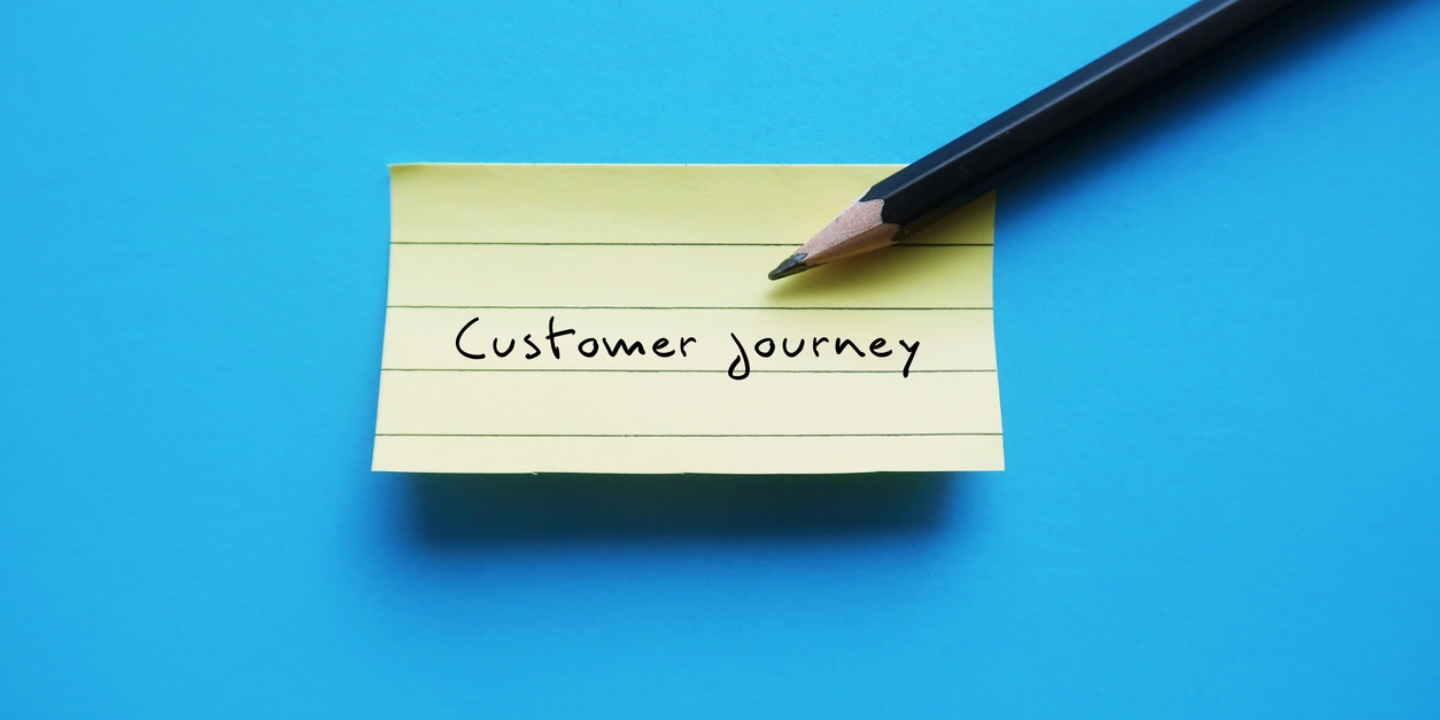

Have you ever wondered why potential supporters choose a different charitable cause over yours? Why your charity’s website attracts many visitors but struggles to engage them fully with your mission? Or why some donors begin the donation process but don’t complete it?
Conducting customer journey mapping (CJM) can provide valuable insights into the motivations, attitudes, and behaviours of your supporters, helping you uncover these answers (and sometime more).
The term ‘customer journey’ refers to a person’s total experience when interacting with your organisation, from first awareness to becoming invested and loyal. A journey can be both online and offline.
Understanding customer journeys reveals potential issues that users might have with journeys on your site and allows you to see how they can be resolved. It also highlights the positive interactions your supporters and beneficiaries have, allowing you to replicate or amplify them. Ensuring that users have a positive experience (or simply an experience that meets their expectations) with your organisation at every step can improve engagement, help with conversion, and turn one-off supporters into advocates for your charity.
- What is customer journey mapping?
- Why create a customer journey map?
- When to use customer journey mapping
- How to put customer experience first in your journey maps
- The customer journey map creation process
- Prioritising your improvements
- Measuring the impact of customer journey mapping
- Is a CJM’s work ever done?
What is customer journey mapping?
A customer journey map visualises a person’s journey when engaging with a product or service. It is a crucial tool in understanding your charitable organisation, your supporters and beneficiaries, and how you can improve your impact.
The art of customer journey mapping involves pulling together every aspect of a supporter or beneficiary’s interactions with your charity. The process includes online and offline presence – your website, any available apps, your mission’s impact, follow-up care, phone conversations, emails, and any interactions with other organisations along the way. Outlining these elements alongside users’ wants, needs and experiences results in a clear and thorough understanding of their successes and pain points.
After gathering the information, the data is collated into an easy to navigate journey map that holds the key to delighting supporters and achieving your charitable objectives.
Why create a customer journey map?
Mapping your users’ journeys doesn’t just help gain more ‘conversions’. It helps gain an in-depth insight into their journey, gives a new perspective, and ensures your charity understands the needs of your supporters and beneficiaries. As journey mapping is a collaborative exercise, it also unites your people in better understanding your mission, objectives, and needs.
Benefits include:
- Discovering ‘moments of truth’ – pain and gain:
- GAIN – learn what works well and replicate it: The map should indicate what is working. You can then dissect and replicate
- PAIN – Understand your sticking points: Research will provide a clear idea of where customers are getting stuck in their journey and where they drop out. Explore these and compare them to areas that are working well and improve them
- Identifying supporter’s and beneficiary’s needs and wants at each stage of their journey: We can facilitate them by really understanding their needs rather than assuming them
- User-centric culture: Developing this shared understanding of the real journey helps give an organisation shared ownership. Having this common goal improves relationships between teams and encourages collaboration and empathy in the workplace
- Easier decision making: A clear understanding of a journey simplifies potentially complex and costly decisions by focusing on the critical pain points and excluding personal preference and bias
- Better employee experiences: Ensuring your employees understand your supporters and beneficiaries leads to autonomy, motivation, and greater focus
- Keeping control when things feel out of control: Global pandemic? New technologies emerging? Having your journey laid out and your goals clear enables your organisation to stay in control when things feel unruly out in the wild
Whilst journey mapping, it’s crucial to include all aspects of the journey, both visible and hidden, as they hold equal importance. This approach allows you to pinpoint pivotal moments and gain a deeper insight into your supporters, especially in areas where emotions are high.
Top Tip:
A comprehensive customer journey map allows you to empathise with supporters or beneficiaries and visualise their entire experience.
When to use customer journey mapping
It is never too early or too late to start understanding your supporter’s or beneficiary’s journeys and improving engagement. Customer journey mapping is relevant at any time and at any organisation age. The prime time for developing a customer journey map is after conducting research, which is critical to keeping your maps authentic rather than basing them on assumptions. While marketers can certainly map supporter journeys using internal knowledge, incorporating insights from audience research provides evidence and often offers a fresh perspective. Research can come in many different forms – looking at analytical data, sending out surveys or feedback requests, holding interviews and testing the website with them (which is called usability testing). Usability tests and customer interviews can be hugely insightful and allow you to speak directly with your users to build that bigger picture. When you’re confident that you have an evidence-based understanding of your supporter or beneficiary journeys, there are many examples of when customer journey mapping can prove very useful:- In preparation for a new charitable initiative, service or website launch – When launching something new, it’s worth investing time to ensure the team has accurate insights to help get it right and understand where and how best to promote it
- Creating a digital transformation strategy – Before embarking on digital transformation, an organisation needs to understand how its audiences use digital touchpoints across their entire journey, plus where there’s opportunity to digitise offline touchpoints
- Feeding into annual planning – Integrating fresh audience research and mapping into our planning process can provide valuable insights that guide our annual strategies. It helps us identify areas of focus and prioritise activities based on the audience’s needs and preferences, ensuring alignment with our charitable goals
- Following poor feedback satisfaction levels – Where a charitable organisation has received feedback that isn’t as positive as it should be, then carrying out research and mapping can help us uncover the underlying reasons for this dissatisfaction
- Dispelling myths and internal assumptions – It’s not uncommon for internal stakeholders to make claims or assumptions without substantial evidence or data to support them. Research and mapping serve as valuable tools to verify information, ensuring accuracy and eliminating any biased elements in our decision-making processes

How to put customer experience first in your journey maps
In a typical journey map, the journey stages are along the top, and the main journey elements are along the side – we’ll explain these below. There are many templates available online for creating journey maps, but the simplest way to start is to get as many people as you can (in-person or virtually) to collaborate and do a post-it note exercise. Journey mapping doesn’t have to be a monumental, day-long exercise. Focussing explicitly on a short journey or a specific part of a journey can uncover some finer details you may not have time for otherwise.Customer experience journey stages
By following the stages of a support or beneficiary’s experience, we can see what they go through on their journey, from being unaware to feeling a loyalty towards your charity. These are the typical customer experience stages we include in our CXJM’s; these can be adjusted (e.g., combined, re-named) to reflect the stages relevant to your organisation or chosen journey.
- Goals – What are the preferred outcomes at this stage?
- Needs – What does a person need at this stage of the journey to encourage progression
- Action – What are people typically doing
- Touchpoints – Where are they doing this (online/offline)? Competitors/other influencers?
- Moments of Truth – What were the specific moments of pain/gain that a person went through at each stage?
The following example shows the combination of journey stage columns and journey element rows to create an overall journey map. Some customer journey maps will also include additional rows depending on the map’s focus, for example a map may include the organisation’s activity and communications to highlight comms strategy opportunities. Journey map stages and elements
Journey map stages and elements
- Find the weakest part of the journey and fix it
- Add more positive moments to a journey that’s average or uneventful
- Create instructions on handling moments of truth for your support staff
- Identify the moments where your charity or your services shine and reinforce or reuse them across other stages
In-practise example
The following use example helps to illustrate what you can do when you look at points on the map where a journey stage (selection) and a journey element (goals) reveal a ‘moment of truth’. At the Selection stage, the user’s goal is to decide on the right cause or service, based on their specific needs. At this point, users have performed their research and may have considered several other organisations. They are looking at their refined options and will likely move to the ‘transaction’ phase. We identify on the completed map that people are not completing their donation journey. The finding allows the team to consider the following:- Is there too much to do, or is the process confusing?
- Is further guidance needed to prompt users to make a final decision
- Are users clear on your charitable mission and how their donation will be used?
The customer journey map creation process
Okay, now you know why and when we should make a customer journey map, and what the key parts of the map are. You’ve got your evidence and research ready too. Now’s the time to create one. We simplify the process of making a customer journey map into three steps: identifying your audiences, the mapping exercise, and the design.
Identifying your audiences
The mapping team (your stakeholders)
At this stage, think about the team that needs to be involved internally and part of the mapping process. The mapping team needs to be diverse as they will represent your charity; we recommend (if possible) including someone from different areas, including marketing and comms, fundraising and customer service. Their feedback and perspectives will be vital to the accuracy of the map, and their input provides a fresh perspective.
Your donors or beneficiaries (or other users)
To understand the journey, we first need to understand the user. It’s now that personas are helpful to the process. Personas are fictional characters based on audience research. For example, they can comprise:
- Potential one-time donor – looking to provide financial contributions to the charity. Donors can be further segmented based on their giving level, frequency, and specific areas of interest
- Newly diagnosed beneficiary – an individual who is new to the cause and needs assistance, services, or support from the charity
- Corporate partner – a business looking for collaborate with the charity by providing financial support, forming a mutually beneficial strategic partnership
We avoid typical ‘marketing personas’ and recommend using ‘needs based’ personas rather than them being based on demographics and interests. If you don’t have personas (or time to create them), consider taking a particular audience segment or customer group.
The mapping
It’s now time to get everyone together with a pack of post-its. Collaboratively start pulling the journey map together using your stakeholder knowledge and your research evidence, by placing content against the appropriate stages and rows.
This will allow you to consider where the opportunities are to improve the journey and what solutions are needed to fix the pain points. You can then brainstorm these ideas, then refine them by deciding what’s feasible, measurable, and has the most significant impact.
It’s important to remember that customer journeys are often not linear and may not fall neatly into these stages. There are lots of different ways to show this. One idea is to use different coloured post-it notes to denote additional actions within a stage or to create different levels underneath your initial journey.
The design
With insight and understanding, it is time to get the learnings designed into a simple and easy to navigate customer journey map.
Typically, we design and save maps as a PDF (or similar) so that teams can access them quickly and explore the contents. Often journey maps are printed out in a large format (such as A1) to be displayed in offices, acting as visual reminders and inspiration for people.
Top Tip:
Our clients often put our maps in pride of place, strengthening that user-centric atmosphere in the workplace.
Prioritising your improvements
Planning is crucial to your customer journey improvement process, and prioritisation is vital. This will ensure you’re focused on the activity that will have the best impact for your charity. A simple way to start is to use the tried and tested method of ‘effort vs impact vs urgency’ scoring. This can show you the exact order of improvements you should work on first and which you can move down the line.
Measuring the impact of customer journey mapping
We always recommend having a measurement plan in place. Without this, it will be harder for an organisation to measure the success of the work c.
A measurement plan in this situation is likely to include:
- The objectives of what you want to achieve – for example, ‘improving the level of information provided to support beneficiaries in reaching the content they need’ or ‘providing better post-donation communications to engage as loyal advocates’
- KPIs – what are the broad key performance indicators that help show if you are achieving the objectives? For example, website traffic or donation amount
- Metrics – what are the individual things you can measure under each KPI to show progress? For example, user sessions, video plays or leads by channel
With thorough measurement planning, it’s possible to relay the issues, subsequent fixes, and project successes of the exercise findings to senior stakeholders, highlighting the work’s impact.
Learn more about measurement planning.
Top Tip:
Ensure your web analytics of choice is tracking correctly and any other tracking required for associated digital activity (email/CRM, social). Then decide how to measure the impact of any changes made to the overall customer experience.
Is a customer journey map’s work ever done?
Journey mapping is not a one-off exercise, and a single designed, implemented and measured map is not the end of the story. We always recommend regularly refreshing them as your charity grows and the journey adapts. Done right, customer journey maps are effective as an ongoing tool for constant improvement, keeping your users at the heart of the organisation and empowering your employees.
There is no hard-and-fast rule on how often you should update customer journey maps as this can vary by the needs of the charitable organisation. However, they might be updated when there is a significant change to your mission, your services or your approaches. Updates might include the launch of a new type of fundraising, a complete redesign of your website or a change in how a service is delivered (i.e., by switching offline touchpoints to being purely online). It makes also sense to update them following any new research, so that they’re as reflective of the users’ current experience as possible.
Regardless of how often they are updated, we recommend implementing a process for reviewing them regularly, whether that’s quarterly, every six months or annually.




